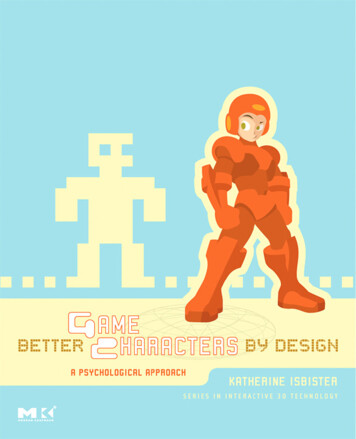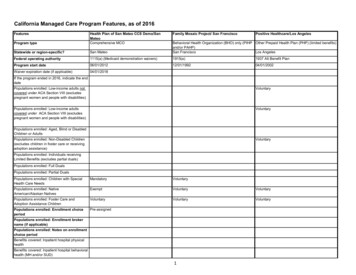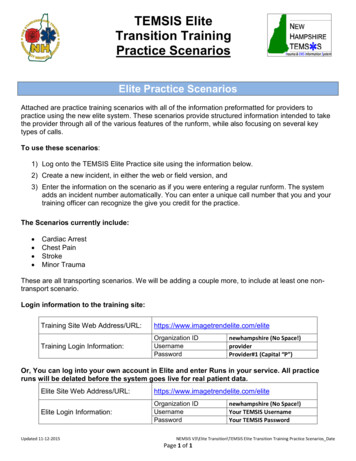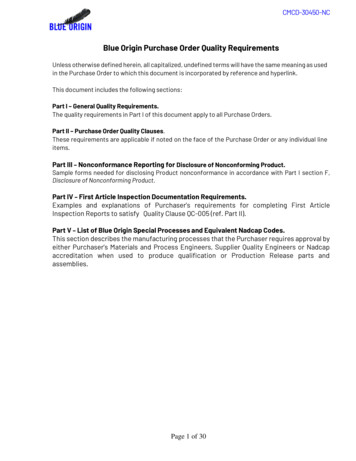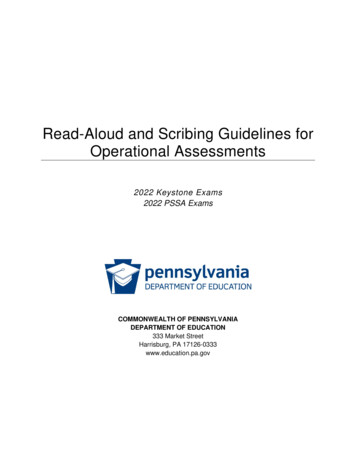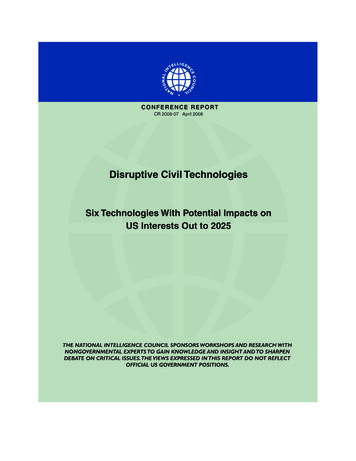
Transcription
This page intentionally left blank.
Disruptive Civil TechnologiesSix Technologies with Potential Impacts on USInterests out to 2025BiogerontechnologyEnergy Storage MaterialsBiofuels and Bio-Based ChemicalsClean Coal TechnologiesService RoboticsThe Internet of ThingsThe National Intelligence Council sponsors workshops andresearch with nongovernmental experts to gain knowledge andinsight and to sharpen debate on critical issues. The viewsexpressed in this report do not reflect official US Governmentpositions.Prepared by SRI Consulting Business Intelligence under the auspices of theNational Intelligence Council. Questions and comments regarding this reportshould be directed to the National Intelligence Officer for Science andTechnology on (703) 482-6811.CR 2008-07April 2008
This page intentionally left blank.
Scope Note: To support the development of the National Intelligence Council’s GlobalTrends 2025, SRI Consulting Business Intelligence (SRIC-BI) was asked toidentify six potentially disruptive civil or dual use technologies that couldemerge in the coming fifteen years (2025). A disruptive technology isdefined as a technology with the potential to causes a noticeable – even iftemporary – degradation or enhancement in one of the elements of USnational power (geopolitical, military, economic, or social cohesion).The six disruptive technologies were identified through a process carried outby technology analysts from SRIC-BI’s headquarters in Menlo Park,California, and its European office in Croydon, England.These analysts are continuously monitoring technology, business, and socialenvironments for two long-term continuous research programs: The SRI Scan program identifies and assesses possible futures bygaining early awareness of signals and patterns of change before theybecome conventional wisdom. The SRI Explorer program identifies and develops an understanding ofhow and why technologies develop. The program also evaluates thecommercial development parameters and uncertainties behind technologycommercialization.Through a process of online discussions, clustering, development oftechnology descriptors, screening, and prioritizing, SRIC-BI Explorer andScan analysts down-selected from 102 potentially disruptive technologies.They identified the following six technologies as most likely to enhance ordegrade US national power out to 2025:BiogerontechnologyEnergy Storage MaterialsBiofuels and Bio-Based ChemicalsClean Coal TechnologiesService RoboticsThe Internet of Things.SRI Consulting Business Intelligencei
PROCESS FOR SELECTION OF DISRUPTIVE TECHNOLOGIES xxxxxxxxx xxxxxxxxx xxxxxxxxxReview of SRIC-BI knowledgebase xxxxxxxxx xxxxxxxxx xxxxxxxxxStep 1: Generate Ideas ( wiki )WorkshopStep 2: Form ClustersStep 3: Describe Technologiesand DisruptionsStep 4: Screen DisruptiveTechnologiesaccording to NICcriteriaStep 5: Select Most CriticalStep 6: Create DisruptiveTechnology xxxxxxxxxxxxxxxxxxSource: SRI Consulting Business Intelligence.SRI Consulting Business xxxxxxxxxxxxxxxxxxxxxxxxxxxxxxxxxx
Executive Summary: Six civil technologies offer the potential to enhance or degrade US powerover the next fifteen years according to National Intelligence Council(NIC) sponsored contractor research. These include biogerontechnology,1energy storage technology, biofuels and bio-based chemical technology,clean coal technology, service robotic technology, and informationtechnology devoted to increased connectivity of people and things.Biogerontechnology offers the means to accomplish control over andimprovement in the human condition, and promises improvements inlifespan. The advancement of the science and technology underlying thebiological aging process has the potential to not only extend the averagenatural lifespan, but also to simultaneously postpone many if not all of thecostly and disabling conditions that humans experience in later life, therebycreating a longevity dividend that will be economic, social and medical innature. The disruptive potential comes in the form of new treatment modalities,shifts in the cost, and resulting allocation and use of health careresources. Nations will be challenged as a result of changing demographicstructures, new psychologies, activity patterns of aging yet healthycitizens, and the resulting requirement to formulate new nationaleconomic and social policies.Energy Storage technologies have the potential to disrupt the way energy isstored and distributed for use in transportation and portable devices.These technologies include battery materials, ultracapacitors, and hydrogenstorage materials (particularly for fuel cells). Within these components bothsynergy and competitive tension exists. The biggest level of disruption that could occur, both in economicterms and in terms of global socio-economic structure, would be thepotential for one of these technologies (or a combination) to lead to aparadigm shift away from fossil fuels.Biofuels and bio-based chemicals production technologies have the onlypotential near-term capability to provide alternatives to conventionalgasoline and diesel-fuel and petrochemical feedstocks. Crop-based biofuelsare already in wide use, work in today’s vehicles, and require no majorinvestments in infrastructure for their use. Biofuels also help to addressglobal-warming concerns by reducing net greenhouse gas (GHG) emissionsfrom vehicles. The rate of technology advancement will be stronglyinfluenced by the regulatory environment and the need to address feedstockconstraints and reduce costs.1Biogerontechnology is technology related to the biological aging processes.SRI Consulting Business Intelligenceiii
The United States and a growing number of other countries have alreadybegun a transition toward biofuels that could ultimately have far-reachingimpacts on world energy markets. A large-scale move to energyefficient biofuels could increase US energy security and easeinternational competition for world oil supplies and reserves. Conversely, if the United States does not develop a strong bio-basedeconomy, the country would become increasingly dependent upon lessthan-friendly countries for a critical energy resource.Clean coal technologies and an array of related technologies offer thepotential to improve electrical generation efficiency, lower emissions ofharmful pollutants, and provide fuels and chemical feedstocks fromavailable coal resources. The development of clean coal technologies isgaining momentum in coal rich nations, which include major economic andscientific powers, but it is not certain to succeed. Failure to successfully develop clean coal technology in anenvironment where there is high expectation of success will result inenvironmental damage with major adverse economic impacts. Conversely, a successful accelerated and rapid deployment of clean coaltechnology could pose a major challenge to other (predominantly oil)energy markets; the resulting geopolitical instability could also be amajor challenge to US interests.Robots have the potential to replace humans in a variety of applicationswith far-reaching implications. Robotics and enabling technologies havealready advanced to the stage where single-application robots and relatedsystems (including autonomous vehicles) are being implemented in a widerange of civil and defense applications. Although a great deal ofdevelopment is still required in terms of intelligence for robots, many of thebuilding blocks for potentially disruptive robot systems are either already inplace, or will be by 2025, including hardware (e.g. sensors, actuators, andpower systems) and software (e.g. robot platforms). The use of unmanned systems for terrorist activities could emergebecause the availability of commercial civil robot platforms will increasesignificantly. Unmanned military systems with a much greater level of autonomy andclosely related/synergistic technologies (e.g. human augmentationsystems) could enhance the performance of soldiers. The development and implementation of robots for elder-careapplications, and the development of human-augmentationtechnologies, mean that robots could be working alongside humans inlooking after and rehabilitating people. A change in domestic andsocial responsibilities and a change in domestic employmentSRI Consulting Business Intelligenceiv
requirements could adversely affect lower income service-orientedworkers.By 2025 Internet nodes may reside in everyday things—food packages,furniture, paper documents, and more. Today’s developments point tofuture opportunities and risks that will arise when people can remotelycontrol, locate, and monitor even the most mundane devices and articles.Popular demand combined with technology advances could drive widespreaddiffusion of an Internet of Things (IoT) that could, like the present Internet,contribute invaluably to economic development and military capability. Streamlining—or revolutionizing—supply chains and logistics couldslash costs, increase efficiencies, and reduce dependence on humanlabor. Ability to fuse sensor data from many distributed objects coulddeter crime and asymmetric warfare. Ubiquitous positioning technologycould locate missing and stolen goods. However, to the extent that everyday objects become informationsecurity risks, the IoT could distribute those risks far more widely thanthe Internet has to date. Massively parallel sensor fusion may undermine social cohesion if itproves to be fundamentally incompatible with Fourth-Amendmentguarantees against unreasonable search.SRI Consulting Business Intelligencev
This is a blank back page, intentionally left blankSRI Consulting Business Intelligencevi
ContentsScope NoteiExecutive SummaryiiiDiscussion1Biogerontechnology1Energy Storage Materials6Biofuels and Bio Based Chemicals11Clean Coal Technologies16Service Robotics22The Internet of Things2732AbbreviationsAppendices2APPENDIX A: Biogerontechnology (Background)APPENDIX B: Energy Storage Materials (Background)APPENDIX C: Biofuels and Bio Based Chemicals (Background)APPENDIX D: Clean Coal Technologies (Background)APPENDIX E: Service Robotics (Background)APPENDIX F: The Internet of Things (Background)2Appendices are available on the accompanying compact disc (CD).SRI Consulting Business Intelligencevii
This page intentionally left blank.SRI Consulting Business Intelligenceviii
DiscussionBiogerontechnologyWhy is Biogerontechnology Potentially Disruptive?Since the start the twentieth century, when the average natural lifespan in the United States was 47years of age, gains in life expectancy have been impressive thanks to a combination of medicalinterventions, lifestyle choices, and behavior modifications. In 2005, the average human lifeexpectancy in the United States was 78 years, with life expectancy for women approximately fiveyears longer than for men. The US Census Bureau estimates that life expectancy will increase byanother six years by 2050. Biogerontechnology, which offers the means to accomplish control overand improvement in the human condition, promises even greater longevity gains. The advancementof the science and technology underlying the biological aging process has the potential to not onlyextend the average natural lifespan forecasts but also to simultaneously postpone many if not all ofthe costly and disabling conditions that humans experience in later life, thereby creating a longevitydividend that will be economic, social and medical in nature. The disruptive potential will alsocome in the form of new treatment modalities, and shifts in the cost, allocation and use of healthcare resources. Nations will be challenged as a result of the changing demographic structures andnew psychologies, behaviors and activity patterns of aging yet healthy citizens and the concomitantneed to formulate new national economic and social policies.Potential Impacts of Biogerontechnology on US National PowerGeopolitical: Biogerontechnology will influence policy making and business decisions related tointernational finance and macroeconomics which will lead to changes in globalinvestment cycles as well as investment flows and economic ties between nations.With health care spending accounting for 16% of GDP in the United States (closer to9% in other OECD countries), the opportunity to reduce that share of spendingthrough biogerontechnology will allow the US government to transfer resources toother areas of the economy and prioritize capital investments that could change thecourse of national economic development. The same goes for many other countries.Nation states may also see a healthy aging population as a labor resource that can beleveraged to assure economic competitiveness in global markets. An aging andhealthy population in the United States that remains economically productive cantherefore contribute towards national economic output and productivity. The abilityto maintain a stable stock of domestic labor may also affect the competitive dynamicsand economics of global labor markets and traditional migration patterns.Economic:If breakthroughs enabled through biogerontechnology were to extend lifespan andcompress morbidity, the costly life stage of frailty and disability that is so commonwith today’s aging populations could be postponed and experienced during a shorterduration of time before death. This, together with a delay in the age at which peoplemay enter age-entitlement and public health care programs, would create significanteconomic savings for the US system. The organization, practice, financing anddelivery of health care could change dramatically in the United States as well as manyother industrialized countries. Biogerontechnology, however, is likely to displacesome of the more conventional gerontology approaches to caring for and providingfor the elderly. As a result, labor markets might be affected as demand for healthservices declines. Labor markets could also be affected by the fact older people maySRI Consulting Business Intelligence1
seek to remain employed longer. As a global business leader, the US may be at theforefront of innovation and new opportunities in businesses, such as financialproducts and services that will seek to capitalize on the longevity boom and riskfactor.Military:Some technologies inherent in the extension of lifespan and healthspan could findimportant applications in a military context primarily those implicated in delaying theonset of biological aging. This would lead to knowledge retention among olderpersonnel as they seek to delay retirement from service. The opportunity to preventthe onset of certain debilitating diseases could lead to significant savings to themilitary’s health system, which would allow resources to be deployed to otherstrategic areas that are more likely to result in aiding the military might of the UnitedStates.Cultural:Inequitable market access to biogerontechnologies that offer life-enhancing benefitsmay create different life expectancy cohorts according to race, income,socioeconomic status, or geography, for example, in the United States.Biogerontechnology could also lead to intergenerational conflicts between youngerand older cohorts and lead to social unrest as investment and employment cycles aredisrupted and affect economic values associated with labor and other capital. Newcultural norms may be established due to changing psychology and behaviors amongolder people, which could also lead to dramatic lifestyle changes. Uncertainties mayemerge as lifestyles converge with and influence technology and market trends inother business sectors as diverse as energy, communications, and finance. Lifestylebehaviors may also lead to the emergence of new health profiles for populations anddisease threats and health risks may change as unexpected behaviors emerge due tobiogerontechnology.Future Scenarios and Potential Impacts on the United StatesThe key uncertainties in the biogerontechnology field tend to fall along two major axes: The science-and-technology–commercialization continuum The formulation of global policy and funding support levels.The key uncertainty along the science-and-technology–commercialization continuum is the extentto which advances in scientific knowledge and technical capabilities occur and the degree of theresulting technical risks and knowledge gaps). Nations will either move toward a more completelevel of understanding and enhanced capabilities or toward an environment of many weak links andunorthodox risks that limit progress towards market applications.The global policy and funding environment will be strongly influenced by the degree and rate ofprogress in scientific and technical capability. The level of public interest and support for longevityscience as well as government’s ability to balance that with commercial interests will also temperthe policy and funding environment.On the basis of the two axes of uncertainty, four distinct scenarios seem plausible: one that isunruly and negative (“Rebel Science”), one that is conservative, having some breakthroughs butthat fall short of the full potential of the technology (“Animal Magic”), and two that have stronglevels of public support but with varying degrees of scientific and technology capabilities (“DorianGray” and “Forever Young”). We describe each of the scenarios briefly and detail the opportunitiesSRI Consulting Business Intelligence2
and threats in the two scenarios that highlight the extremes in possibilities for how the future couldplay out until 2025.Table 1BIOGERONTECHNOLOGY: FUTURE SCENARIOSScience and Technology Commercialization ContinuumWeak Links and RisksNew Science WorldLimited Scientific andTechnical RationaleRebel ScienceAnimal MagicStrong SupportAnd Public DemandDorian GrayForever YoungGlobal Policy andFundingSource: SRI Consulting Business Intelligence.Scenario 1: Animal MagicIn “Animal Magic” the promise of biogerontechnology is ushered in but only in research involvinganimal models. Scientists are in disagreement as to the exact mechanisms for how these researchresults could be reproduced in humans. Despite this disagreement and the fact that there has beenno reproducibility of the animal research results in any human studies, researchers remainemboldened that the critical breakthrough in humans is near. Policy makers and the public aregrowing increasingly skeptical the longer the impasse continues. Other fields of biomedicalresearch that seek to affect aging and the decline in health have borne many more breakthroughs inclinical potential, and gain greater attention and interest from the public and policy makers.Scenario 2: Dorian GrayIn “Dorian Gray” all is good on the public face of science but less so within the research field onaccount of limited progress in advancing biogerontechnology. Both the public and policy makerswant to believe in a dream and urge scientists to forge ahead. But scientists feel pressured to takerisks and make unorthodox decisions in their research, which leads to some risky research andunexpected outcomes. Spin sells the public and policy makers a sense of progress. The US andother governments continue to pour significant amounts of funding into research but with little toshow for it. Yet a sense of optimism in the future remains. Governments support and the publicpursues interim strategies, such as caloric restriction, to slow down aging while awaitingbreakthroughs in biogerontechnology.Scenario 3: Rebel ScienceIn “Rebel Science” biogerontechnology fails to realize its full potential and advance to a level thatscientists had once anticipated. Scientists, however, remain confident that it is only a matter of timebefore the critical breakthroughs, which push biogerontechnology to the next level, emerge. Theglobal policy and funding environment remains unconvinced and is cool to heed calls fromscientists for further funding. Scientists seek to compensate for the lack of funding from publicSRI Consulting Business Intelligence3
sources through tapping wealthy individuals and technology philanthropists. But desperation and alack of accountability and formal oversight forces researchers into some unorthodox situations. TheUS government is forced to introduce tough legislation governing research activities, which drivesmuch of the ongoing research underground or offshore. The biomedical industry sees littleincentive to invest heavily in the field because of the growing restrictions. Experimentation onhumans is unregulated, fails to follow standard ethical guidelines, and clinical applications thatemerge often go unreported such that any knowledge learned is not shared and used to advanceknowledge in the field. Potential opportunities. Governance issues loom large. The United States is well positioned toassume a leadership role in the international science and technology community to establishguidelines and frameworks governing ethical practices in biogerontechnological research.Domestically, the United States could pursue and prioritize or earmark available funding foralternative areas of biomedical research that offer the greatest opportunity to delay the onset andimpact of diseases associated with aging. Potential threats. The United States is alarmed by the degree to which international markets andscientific research remain unregulated. Private money and venture philanthropy pose asignificant challenge to the regulated practice of biogerontechnology research and adherence tothe ethics of biomedical research. Despite international efforts to restrict or ban researchactivities, these research initiatives are always sure of finding a safe haven where authorities arewilling to turn a blind eye.Scenario 4: Forever YoungIn “Forever Young” the breakthroughs that scientists envisioned for treating aging as a medicalcondition have come to pass. The US academic biomedical research community benefits greatlyfrom the research and innovation and the resulting technology transfer to the private sector resultsin considerable entrepreneurial activity that drives a new era of technology-led economic activity toboost national economic growth. Governments talk of the longevity dividend that will stem fromthe clinical applications and convene international meetings to discuss the challenges in applyingand managing biogerontechnology in society in a controlled and responsible manner. Theimplications of advances in biogerontechnology will extend beyond medicine and health care. Thebenefits of healthier and more active lifespans will allow people to remain in the labor force andwork longer and to enjoy more active lifestyles. As a result, consumer spending and savingspatterns adjust to reflect changing lifestyle interests. Actuaries would need to make ongoingupward adjustments to reflect expanding lifespans. The implications of longevity risk would startto feed into policy making and business decisions as finance and economic strategies adjustaccordingly. Government and private pensions would need to guarantee sufficient resources tomanage the costs of extended life spans, while retirement assets would see a more gradual drawingdown as aging investors live longer. There is a sense of optimism, hope, and possibility in manyglobal societies that permeates beyond the field of biogerontechnology and feeds into other areas ofthe economy and society. Potential opportunities. The uptick in investment levels in commercialization activities aroundbiogerontechnology research pushes the US government into action. Key policy initiatives dealwith legal frameworks for intellectual property protection, regulatory frameworks governinghuman clinical safety and evaluation, and consumer education campaigns regarding theSRI Consulting Business Intelligence4
responsible use of biogerontechnology. US companies are quick to make the strategicinvestments in enabling technologies and market infrastructures. Potential threats. This scenario could have very significant social and political impacts forwhich many policy makers are unprepared. For example, the United States is simply unpreparedfor the ideological and cultural backlash against biogerontechnology, which leads to manytensions and divisions within society. The United States and other countries are left to grapplewith the economic burden that results from unintended consequences of covering payment foraccess to medical technologies that guarantee a longer-living and healthier life, and resort tocreating policies that ration or restrict access to biogerontechnologies on the basis of anindividual’s willingness to pay.Signposts to MonitorScenarios exist because of the uncertainty that is inherent with any view of the future. Determiningwhich scenario best mirrors reality at any one time depends on careful assessment of reliableinformation and knowledge and monitoring various signposts that would indicate the direction andpace with which any field of uncertainty (in this case, relative to enabling the disruptive potential ofa technology to US interests) is advancing. Key variables, which, if positive, would indicateenvironments that are supportive toward biogerontechnology development, include: Scientific evidence that both confirms and disconfirms the current aging theories, Global public research funding levels and trends for biogerontechnology research, The establishment of non-US centers of biogerontechnology research excellence, Successful early models for scientific research and technology commercialization, The size and nature of biogerontechnology investments worldwide, Position statements about the ethics and practices of biogerontechnology research, Consistency in regulatory frameworks governing research and commercialization, and The influence of scientific research and applications on public opinion.SRI Consulting Business Intelligence5
Energy Storage MaterialsWhy Are Energy Storage Materials Potentially Disruptive?The term Energy Storage Materials encompasses a wide range of materials and techniques forstoring energy, each with varying levels of potential disruption. This profile focuses on three suchenergy storage materials groups battery materials, ultracapacitors and hydrogen storage materials(particularly for fuel cells). They have in common the potential to disrupt the way energy is storedand distributed in two main industry sectors, transportation and portable devices. Within theseenergy storage materials groups, both synergy and competitive tension exists. In somemanifestations of their potential disruptions the technologies will work in parallel; in others theywill compete with each other.The biggest level of disruption that could occur, both in economic terms and in terms of globalsocio-economic structure, would be the potential for one of these technologies (or a combination) tolead to a paradigm shift away from fossil fuels. In this context, one potential scenario is based on amove to a hydrogen economy. Such a move will largely depend on the ability to generate hydrogenfrom a non-petroleum source. It might also be important for hydrogen generated from natural gasor coal. Such a move will be very dramatic if the source of the hydrogen is water that has been splitby a non-fossil source of electricity, including nuclear, solar, wind, or other alternatives.Potential Impacts of Energy Storage Materials on US National PowerDepending on the path of the future scenario, energy storage materials could have a substantialimpact on the four elements of national power:Geopolitical: Energy storage materials could have a profound impact on the geopolitical balance ofpower. Some forecasters predict that oil has already or soon will reach its productionpeak, just as many countries, such as China and India, are beginning to expand theireconomies and place more demand on oil resources. Cheap reliable sources ofalternative energy storage could reduce the demand for oil, particularly fortransportation, though other primary sources of energy (specifically, electricity) willbe necessary to supply the energy to recharge batteries, provide the charge forultracapacitors, or generate hydrogen. Reduced oil demand would insulate the UnitedStates from its dependency on foreign sources of oil. On the hand, nations reliant onpetroleum as a major source of revenue would find that they would have to transitiontheir economies, or risk a substantial reduction in living standards. Such a situationcould destabilize some already fragile regions.Economic:A transition to a hydrogen economy, and to greater use of other energy storagematerials, would provide a large opportunity in the production of fuel cells and fuelcell vehicles, hydrogen generation and storage infrastructure, advanced batteries andultracapacitor production and materials. From a transportation perspective, gasolineretailers would have to transition their infrastructure to provide onsite generation andstorage of hydrogen, creating a demand for local high-voltage electricity substations.Any move away from hybrids to full electric vehicles would be detrimental tomanufacturers of internal combustion engines. Assuming these new sources ofpower are as cheap to the US end user (be they auto manufacturers or consumers),then the transition should be economically positive at a national level, due to theSRI Consulting Business Intelligence6
reduction in demand for overseas oil (and assuming increased electricity requirementsare from indigenous sources).Military:The military has a substantial demand for offsite and portable power. Increases inenergy density anticipated through this disruptive technology would provide greaterautonomy of operation for field devices, and might enable remote sensors to have agreater lifetime. The high bursts of power provided by ultracapacitors can pr
SRI Consulting Business Intelligence i To support the development of the National Intelligence Council's Global Trends 2025, SRI Consulting Business Intelligence (SRIC-BI) was asked to identify six potentially disruptive civil or dual use technologies that could emerge in the coming fifteen years (2025). A disruptive technology is
